Sailing to Colombia through the idyllic San Blas Islands
- bstclair579
- Mar 14, 2024
- 4 min read
Updated: Apr 10, 2024
After sticking Hank into a shipping container bound for Colombia, and Sheri joining me in Panama City for a couple days, we headed to the Caribbean Coast to sail to Colombia. We hired a sailboat through Blue Sailing. Our boat was a 48 foot single-hull boat, impeccably maintained by our captain, Daniel, and his crew from Colombia, Catalina and Frederic. Daniel seemed very competent and safe, which we appreciated. Our boat-mates were nine adventurous backpacker tourists - four women from England and one woman from France, three guys from England (two now living in Australia), and one guy from Germany. All had been traveling through Latin America for quite some time. Everyone was super nice and a great group to spend some days with. We bunked in the rear of the boat (which was much better in the rougher water ahead) in a double bed with our bunkmate, Grace, above us in a narrow single bed (which was quite a challenge to climb into and out of in the night, which Grace managed well -- I certainly would not have). We spent three days in the San Blas Islands and then about 38 hours on a straight path over open seas to Cartagena.
The San Blas Islands number about 365 coconut-covered islands and cays, of which 49 are inhabited. They are part of a large indigenous reserved called the Guna Yala Camarca, which includes much of the northeast coast of Panama and the adjacent islands. It is home to the Guna people. They number about 50,000, most who live in the Camarca. They are a fiercely independent people, very traditional and resistant to assimulation into HIspanic culture. During the first decades of the 20th century, the Panamanian government tried to supress their traditions, which lead to a successful revolt in 1925 resulting in a great degree of authonomy for the Guna.
The Guna are famous for their brightly-colored molas that are traditionally worn sewn on to women's blouses. It is made using a reverse applique technique where several pieces of differently colored cloth are sewn together and then cut with scissors and stitched to form patterns. They originated from the tradition of Guna women painting patterns on their bodies. Traditonal molas are symbolic geometric patterns, whereas more recent molas include different animals and plants and landscapes found in nature. They are an incredible amount of work, and have become an important source of income from the sale to tourists and collectors. And they have become a national symbol of Panama.
Sheri and I bought a beautiful mola sewn onto a blouse from a woman selling them from her canoe in the islands. We also visited the Mola Museum in Casca Viejo in Panama City and learned much about molas and the Guna. We also bought three beautiful molas from a nice couple in a plaza in Casco Viejo. The husband was quite proud of his wife's molas - said she got second place in a contest.
The three days on the islands were wonderful. The first day started out a bit sketchy since the ride from Panama City to the Caribbean was scary. Our driver drove very fast, close to other cars, constantly looked at his phone, and danced to his music. I think it might have been the most dangerous thing we have done in Latin America. We arrived mid-morning at a boat launch and climbed into a motor boat for a ride out to our sailboat at El Porvenir. After our captain, Daniel, took our passports and had them stamped with our visas, we headed to our first island. This was our "tourist" island, which meant there was a small bar there. We got to know each other, swam, played volleyball, and had a nice meal before heading back to the boat for the night,
On our second day, we went to Cayos Holandeses, a beautiful set of islands with crystal-clear blue and turquoise waters. We first went snorkeling along a beautiful coral reef with many fish and some very large eagle rays. Sheri and I had been so looking forward to snorkeling in a beautiful place. We then spent the rest of the day on the island and had a wonderful meal of fresh fish for lunch, caught and prepared by the family that lived on the island. Back to the boat, a beautiful sunset, and enjoying each others company before crashing into bed.
Before heading out on the third day, Catalina, Frederic and Daniel had a mission to rescue a sweet older dog named Perrito. Another dog on the island was aggressive to other dogs, so Catalina was determined to rescue Perrito and take him home to her daughters in Cartagena. We loaded him onboard, where he became a quiet, well-behaved, and well-liked member of our boat crew. We then headed to our third island at the east end of the San Blas Archipelago. Another nice relaxing day. No other people were on the island. We also got to swim with some very docile nurse sharks.
We left in the early evening of the third day and made a beeline for Cartagena across open seas. Thankfully Sheri bought us enough Dramamine to last us for the crossing, and Daniel told us to be sure to take some every four hours. We were lucky. The seas were rough, but not as rough as other times during the last few months. Some on the boat got seasick, but Sheri and I did well. We arrived in Cartagena in the middle of the second night. Catalina's daughters were quite excited to meet Perrito, and Perrito was a very happy dog. After some heartfelt goodbyes to our new friends, we were on our way to our next adventures.

















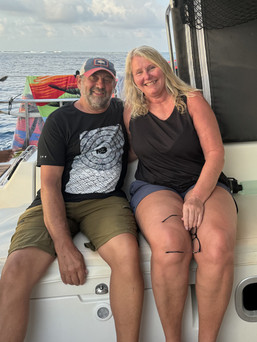

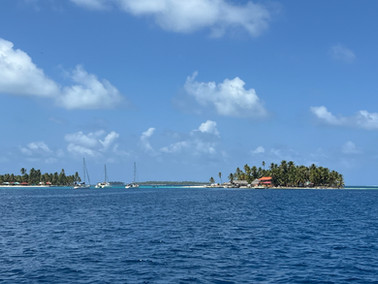












































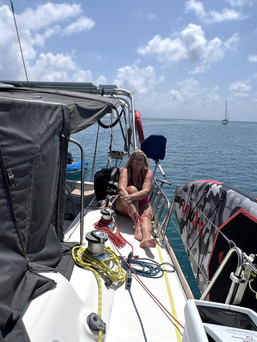



























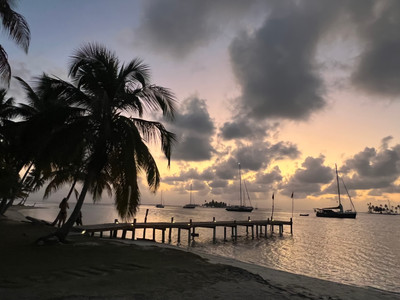















































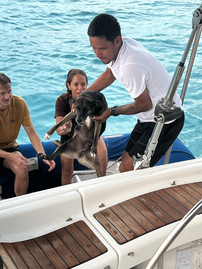





























































Remind me why you left those islands!?!?
Food looks great. Dog looks very happy! Sounds like a fun sail :-)